- Home
- Devdutt Pattanaik
Jaya: An Illustrated Retelling of the Mahabharata Page 2
Jaya: An Illustrated Retelling of the Mahabharata Read online
Page 2
Astika’s question boomed across the sacrificial hall. The chanting stopped. The fire stilled. Silence descended as curious eyes fell on the king.
Janamejaya pulled back his shoulders and replied with conviction, ‘I do this for justice.’
Astika retorted passionately, ‘Takshaka killed your father for justice. You kill the Nagas for justice. The orphans you create by this yagna will also crave for justice.
Who decides what justice is? How does one end this unending spiral of revenge where everyone believes they are right and their opponents are wrong?’
Janamejaya was silent. He pondered over what Astika had said. Then he asked, with a little hesitation, ‘Did the Pandavas not fight the Kauravas for justice?’
Astika replied, ‘No, my king. That war was about dharma. And dharma is not about justice; it is about empathy and wisdom. Dharma is not about defeating others, it is about conquering ourselves. Everybody wins in dharma. When the war at Kuru-kshetra concluded even the Kauravas went to paradise.’
‘What!’
‘Yes. The Kauravas, reviled as villains by you and your forefathers, went to Swarga, that abode of pleasure where the gods reside.’
‘And the Pandavas?’ asked the king, disturbed by this revelation.
‘They went to Naraka, that realm of pain.’
‘I never knew this.’
‘There is so much you don’t know, my king. You may have inherited the kingdom of the Pandavas but not their wisdom. You do not even know the true meaning of dharma that was revealed to Arjuna by God himself.’
‘God?’
‘Yes, God. Krishna!’
‘Tell me more.’
‘Send for Vaisampayana,’ said Astika, ‘Ask him to narrate the tale that was composed by his teacher, Vyasa, and written down by Ganesha. It is the tale of your forefathers, and all those kings who came before them.’
Messengers were sent to fetch Vaisampayana, guardian of Vyasa’s great tale. When Vaisampayana finally arrived, he saw in the sacrificial hall thousands of serpents suspended above a sacrificial fire, hundreds of priests around the altar impatient to complete their ritual, and a king curious about his ancestry.
The storyteller-sage was made to sit on a deer skin. A garland of flowers was placed around his neck, a pot of water and a basket of fruits were placed before him. Pleased with this hospitality, Vaisampayana began his tale of the Pandavas and the Kauravas and of all the kings who ruled the land known as Bharata. This was the Jaya, later to be known as the Mahabharata.
‘Listen to the tale carefully, Janamejaya,’ Astika whispered in the king’s ear, ‘Do not be distracted by the plots. Within the maze of stories flows the river of wisdom. That is your true inheritance.’
In the Vedic age that thrived around 1000 BCE, yagna was the dominant ritual that bound society. It was performed by specially trained priests who chanted hymns and made offerings into fire in a bid to invoke cosmic forces and make them do man’s bidding. A Sattra was a yagna performed on a grand scale with hundreds of priests over several years.
While rituals helped man cope with the many material challenges of the world, they did not offer man any spiritual explanations about life. For that stories were needed. And so, during yagnas, and between them, bards were called to entertain and enlighten the priests and their patrons with tales. In due course, the tales were given more value than the yagna. In fact, by 500 CE, the yagna was almost abandoned. Sacred tales of gods, kings and sages became the foundation of Hindu thought.
The Mahabharata is populated not only by Manavas or humans but also by a variety of beings such as Devas who live in the sky, Asuras who live under the earth, Apsaras or nymphs who live in rivers, hooded serpents who talk called Nagas, forest spirits called Yakshas, warrior-musicians of the woods called Gandharvas and brute barbarians called Rakshasas. Some like Asuras and Rakshasas were hostile to humans and hence deemed demons, while others like Devas and Gandharvas were friendly hence worshipped as gods and demi-gods. The Nagas had an ambiguous status, sometimes feared and sometimes worshipped. Rationalists speculate that these various non-human races were perhaps non-Vedic tribes that were gradually assimilated into the Vedic fold.
It is said that the chief priest, Uttanaka, who was conducting the Sarpa Sattra had his own grouse against the Nagas. As part of his tuition fee, his teacher had asked him to give his wife the jewelled earrings of a queen. With great difficulty, Uttanaka had managed to get such earrings but these were stolen by the Nagas. To avenge that theft, Uttanaka wanted to perform the Sarpa Sattra. But he did not have the wherewithal to conduct it. King Janamejaya, in his quest to avenge his father’s death, inadvertently provided him with the opportunity. Thus while Janamejaya thought his was the only reason for the sacrifice, he was mistaken. There were many besides him who wanted to destroy the Nagas.
Janamejaya’s family line
Book One
Ancestors
‘Janamejaya, what happened before repeated itself again and again in your family history.’
1
Chandra’s son
When a man dies, he can, if he has earned enough merit, enter the paradise of the gods located high above the clouds. Humans call this realm Swarga. Its residents, the Devas, know it as the city of Amravati. Here there is no pain or suffering; all dreams are fulfilled and all wishes are granted.
To sustain this delight, the Devas have to at regular intervals defeat their eternal enemies, the Asuras, who live under the earth. Their victory depends on the power of yagna. Brihaspati, god of the planet Jupiter, performs the yagna for the Devas. For the ritual to be successful, Brihaspati needs his wife, Tara, goddess of the stars, to sit by his side.
But one day, Tara left Brihaspati’s side and eloped with the moon-god, Chandra. Tara had grown tired of her analytical husband, who was more interested in ritual than her. She had fallen in love with the passionate Chandra who adored her.
‘Bring my wife back if you want the yagna to succeed,’ said Brihaspati to Indra, king of the Devas.
The Devas were divided: should they force Tara to return to her husband, who saw her merely as an instrument of ritual, or should she be allowed to stay with her lover, who made her feel alive? After much debate, pragmatism prevailed. The yagna of the Devas was more important than the happiness of Tara; without the power of yagna, the Devas would be unable to shower the earth with light and rain. Without yagna, there would be darkness and drought on earth. No, Tara had to return to Brihaspati. This was Indra’s final decision.
Tara returned reluctantly. When she came, it was clear she was with child. Both Chandra and Brihaspati claimed to be the father. Tara remained silent, stubbornly refusing to give out the identity of the man who had made her pregnant. Then, to everyone’s astonishment, the unborn child cried out, ‘Tell me mother, of which seed am I fruit? I deserve to know.’
Everyone assembled was impressed by the unborn child’s desire to know the truth. They declared this child would be the lord of Buddhi, the intellect, that part of the mind which enables one to distinguish truth from falsehood and thereby make choices. He would be called Budh.
Compelled by her child, Tara lowered her eyes and said, ‘You spring from Chandra’s seed.’
Hearing this, Brihaspati lost control over his dispassionate disposition and lashed out in rage, ‘May this love-child of my unfaithful wife be of neuter gender, neither male nor female.’
The gods were horrified by this cruel curse. Indra intervened in his capacity as king. ‘The child you so contemptuously cursed, Brihaspati, will henceforth be known as your son, not Chandra’s. It does not matter who sowed the seed in the field; what matters more is who the master of the field is. As Tara’s lawfully wedded husband, you are the master, the father of all of her children, those born after marriage or before, by you or by anyone else.’
So it came to pass, Tara gave birth to Budh, lord of planet Mercury, a shape-shifting liminal being, neither male nor female. Biologically, he descended f
rom the emotional Chandra but as per Indra’s decree, he was raised in the house of the logical Brihaspati.
Since that day, law took precedence over natural phenomena in heaven and on earth; fatherhood was defined by marriage. That is why Janamejaya’s great grandfather, Arjuna, would be called a son of Pandu even though Pandu was incapable of fathering children.
For humans, the Amravati of the Devas is the paradise of pleasure that one can go to if one lives a meritorious life.
Muthuswami Dikshitar, the 18th century doyen of Carnatic music, in his kriti dedicated to the Nava-grahas, or nine celestial bodies of astrology, refers to Mercury as being neuter. In many images of Nava-grahas, Budh is sometimes shown as male and sometimes as female, suggesting his nature is mercurial.
The Devas are sky-gods, the enemies of Asuras who live under the earth. Their fights are endless. Their alternating victory and defeat ensure the rhythmic change of seasons.
In art, Budh rides a Yali, a mythical creature that has the head of an elephant but the body of a lion, a reminder of his liminal nature.
2
A wife for Budh
As Budh grew up he wondered if he would find anyone to share his life, for he was neither man nor woman. ‘We will get you married,’ Tara said with confidence.
‘To whom, mother, a husband or a wife?’ asked Budh.
‘Whatever fate considers appropriate,’ said Tara. ‘Everything in this world happens for a purpose. Your father’s curse must have a reason. It will all work out. Have faith.’
Sure enough, one day Budh saw a woman called Ila, and fell in love.
But Ila was no woman; she was once a man, a prince called Sudyumna, son of Manu, the first king of humans.
One day Sudyumna had ridden into a forest over which the great hermit Shiva had cast a spell that turned all male creatures into females. Lions of the forest had turned into lionesses and peacocks into peahens. Shiva had done this to please his consort, Shakti, who did not want any male, animal or human, to disturb her when she was in the company of her lord. When Sudyumna realized that he had lost his manhood in the forest, he begged the goddess to restore it. ‘I cannot undo Shiva’s spell,’ she said, ‘but I will modify it so that you will be a woman only when the moon wanes and a man when the moon waxes.’
Budh who was neither male nor female found a perfect spouse in Ila who was both male and female. Together they had many sons. They were called the Ailas, the descendants of Ila. They were also called the Chandra-vamsis, descendants of the moon, a title that did not quite please either Brihaspati or the Devas. This is why perhaps logical reasoning often eluded the passionate kings of this lineage.
In time, the Chandra-vamsis would forget the gender ambiguity of both Budh and Ila. They would mock it when it would become manifest in Arjuna’s brother-in-law, Shikhandi. They would stop him from entering the battlefield. Such is the nature of man-made laws: ignorant of the past and insensitive to the present.
The Mahabharata tells the stories of the Chandra-vamsis, descendants of the moon, or rather Budh-vamsis, descendants of Mercury, who were infamous for their moral ambiguity, and quite different in character from the upright Surya-vamsis, descendants of the sun, whose tales are told in the Ramayana.
Boons and curses are an integral part of Hindu mythology. They are rooted in the concept of karma that states that all actions have reactions that one is obliged to experience in this life or the next. Actions that yield positive results are punya; in narratives they take the shape of boons. Actions that yield negative results are paap; in narratives they take the form of curses. Punya is spiritual merit that generates fortune and paap is spiritual demerit that generates misfortune. The concept of paap and punya is meant to explain why bad and good things happen in the world.
The story of Ila being both male and female is found in the Mahabharata and in many Puranas. In some retellings, Ila is called the daughter of Manu. While performing a yagna for a son, Manu mispronounced the magic formula and ended up with a daughter instead.
Manu was the son of Surya, the sun-god. Besides Ila, Manu had another son called Ikshavaku whose descendants came to be known as Surya-vamsis, or the solar line of kings. This line included Ram, prince of Ayodhya, whose tale is told in the Ramayana.
The story of the star-goddess’ tryst with the moon-god attempts to explain the behaviour of lunar kings through Jyotish-shastra, or Vedic astrology. Moon is associated with emotions, Jupiter with rationality and Mercury with clarity, communication and cunning. The story suggests that the Chandra-vamsis were by nature rather emotional, a trait that needed to be contained by logic.
3
Pururava’s obsession
Pururava, a Chandra-vamsi, once saw Urvashi bathing in a river. Urvashi was an Apsara, a river-nymph, who lived with the gods and only occasionally stepped on earth. She was so beautiful that when she walked, all the animals stopped to gaze at her; every tree, every bush, every blade of grass reached out to touch her. Pururava fell in love with her. ‘Marry me,’ he said. ‘Be my queen and live in my palace.’
In a spirit of play, the nymph indulged the king and said, ‘Only if you promise to take care of my pet goats and never let anyone but I see you naked.’ To her great surprise the mortal Pururava agreed, leaving her no choice but to become his wife.
It was a new experience for Urvashi and she enjoyed it. She bore her human husband many sons.
It is said that the lifetime of man is just a blink of Indra’s eye. And yet, Indra could not bear this momentary separation from Urvashi. He ordered the celestial musicians known as Gandharvas to bring her back.
The Gandharvas stole Urvashi’s pet goats from under her bed while Pururava was busy making love to her. Urvashi saw this from the corner of her eye and cried in a stricken voice, ‘My goats! Someone is stealing my goats! Keep your promise, husband, and bring them back.’
Pururava immediately jumped off the bed and ran to catch the thieves without bothering to cover himself. As he ran out of the palace behind the thieves, Indra hurled a thunderbolt across the sky. In the flash of the lightning, everyone in the city saw Pururava naked. The condition that kept Urvashi on earth, away from the gods, was as a result broken. It was time for her to return to Amravati.
Without Urvashi, a heartbroken Pururava became mad and could not rule. Such is the power of passion. The Rishis were forced to replace him with one of his more disciplined sons, one more fit to rule.
Some say, Pururava still weeps in the forest and scours the riverbanks in search of Urvashi. Others say, she has turned him into a Gandharva and he follows her wherever she goes as music maker to her dance.
The obsessive passion of Pururava for Urvashi that led to his downfall would become manifest generations later in Shantanu, not once but twice, first in his love for Ganga and then his love for Satyavati, with the same disastrous consequences. Because human memory is short, and history always repeats itself.
Apsa means water and so Apsara means a water-nymph. Water comes to earth from the heavens in the form of rain and returns after a brief stay. This water sustains life on earth. Thus the story symbolically refers to the craving of man (Pururava) for water (Urvashi) that comes from, and eventually returns to, the sky (Indra).
Urvashi lays down conditions that have to be met before she accepts any man as husband. It suggests a pre-patriarchal society where women were mistresses of their own sexuality. In Vedic society, women were considered extremely valuable because only through them could a man father a child, repay his debt to his ancestors and keep rotating the cycle of rebirths.
Pururava’s yearning for the elusive and ethereal Urvashi forms a dialogue that is recorded in the Rig Veda, the oldest Vedic text, dated conservatively to 1500 BCE. In Kalidasa’s play, Vikramorvasiyam, written in 500 CE, two thousand years later, Pururava is a dashing king who does not chase the nymph. It is she who chases him; the gods allow her to stay with him provided he never sees the child she bears him. Urvashi therefore secretly delivers t
he child while he is away attending a yagna, and requests the sage Chyavana to raise him in secret. Years later, the inevitable happens: the father sees the son and the nymph returns to the abode of the gods. After a long period of separation, Indra lets Urvashi return to Pururava because he needs Pururava’s help in his battles against the Asuras.
According to the Kalpasutra, Pururava’s first son by Urvashi, Ayu, established the kingdom of Kuru-panchala in the east while their second son, Amavasu, established the kingdom of Gandhara in the west. These kingdoms set the stage for the great war at Kuru-kshetra.
4
Shakuntala’s innocence
A king called Kaushika, a Surya-vamsi or descendant of the sun, wanted to become a Rishi. So he gave up his material possessions, took the vow of celibacy and started performing ascetic practices known as tapasya. If successful, he would become more powerful than any man, or god.
Fearing that Kaushika intended to displace him, Indra sent an Apsara called Menaka to distract Kaushika. Of all the damsels in Amravati, Menaka was the most beautiful. Kaushika lost all control of his senses when she danced before him. He abandoned his tapasya, forgot his vow of celibacy, and surrendered to passion. From that union of hermit and nymph was born a girl.

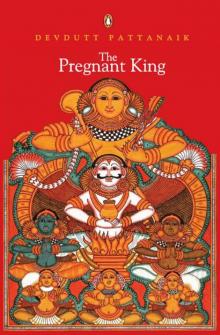 Pregnant King
Pregnant King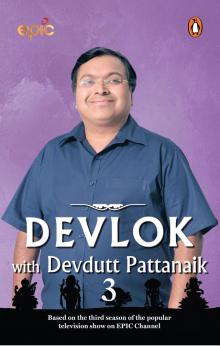 Devlok With Devdutt Pattanaik: 3
Devlok With Devdutt Pattanaik: 3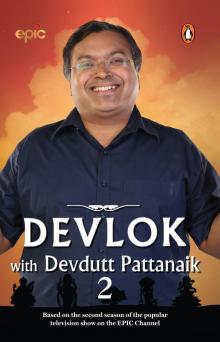 Devlok With Devdutt Pattanaik
Devlok With Devdutt Pattanaik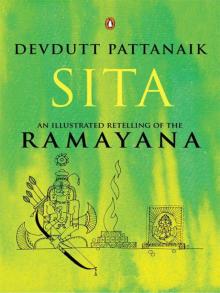 Sita: An Illustrated Retelling of the Ramayana
Sita: An Illustrated Retelling of the Ramayana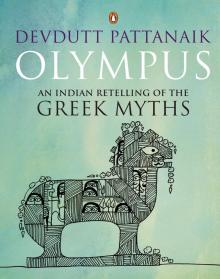 Olympus
Olympus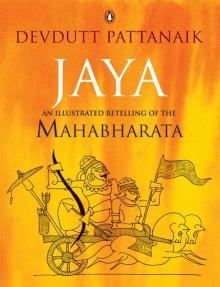 Jaya: An Illustrated Retelling of the Mahabharata
Jaya: An Illustrated Retelling of the Mahabharata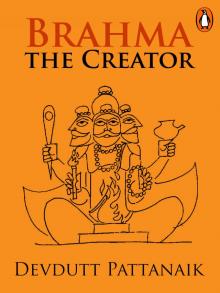 Brahma
Brahma